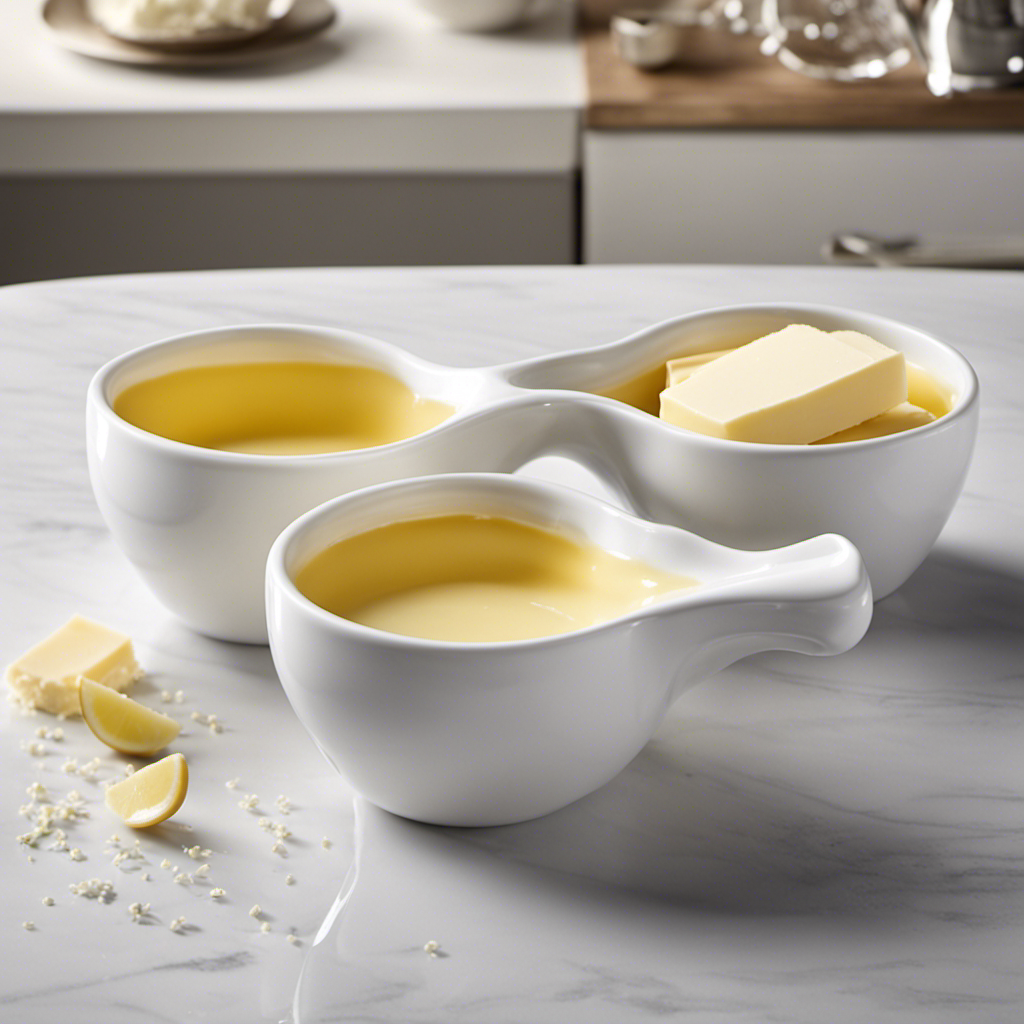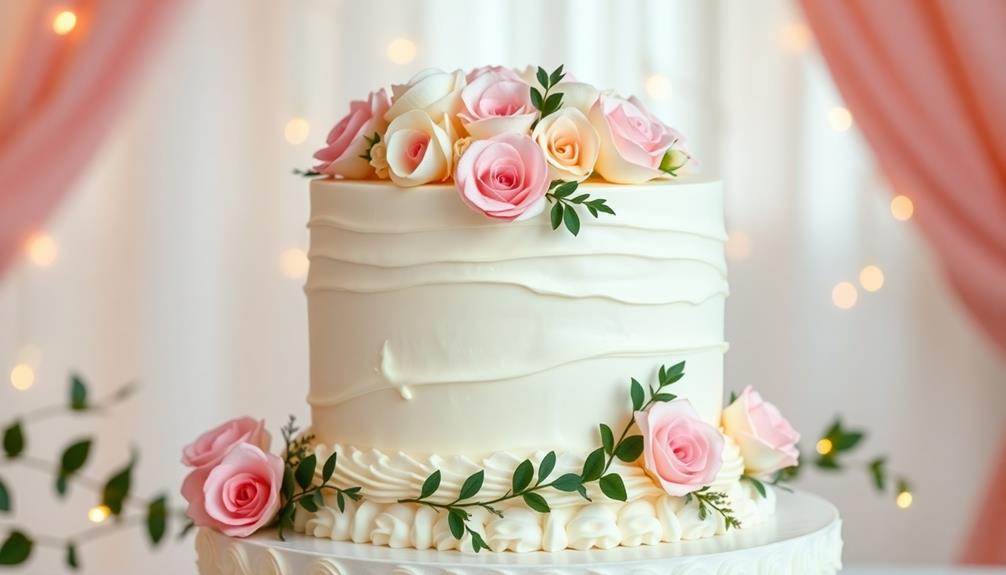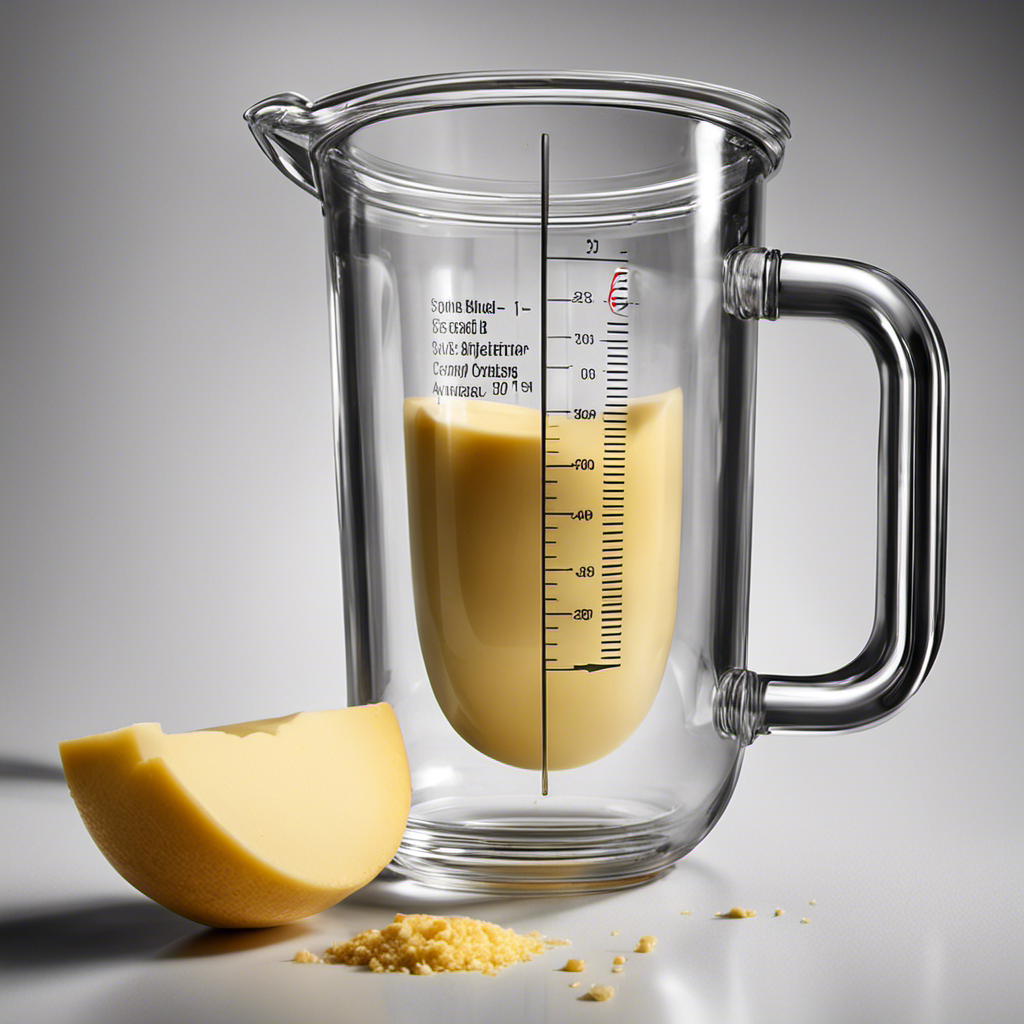I frequently find myself in the kitchen, enveloped in the soothing scent of baked goods. However, as I grab a cup of butter, I’m left pondering, ‘What’s the ounce equivalent of one cup?’
This question is not uncommon, as precise measurements are crucial in the world of baking. In this article, I will unravel the mystery and provide you with the scientific knowledge you need to convert cups to ounces and measure butter with ease.
So, let’s dive in and uncover the secrets of butter measurements together.
Key Takeaways
- Butter is usually sold in sticks, with each stick containing 4 ounces or 1/2 cup of butter.
- One cup of butter is equal to 8 ounces.
- Converting cups to ounces requires a simple conversion formula.
- Precise measurements are crucial in baking.
Understanding Butter Measurements
One cup of butter is equal to 8 ounces.
When it comes to converting butter measurements, it’s important to understand the different types of butter measurements that exist.
Butter is usually sold in sticks, and each stick typically contains 4 ounces or 1/2 cup of butter. This means that if a recipe calls for 1 cup of butter, you would need 2 sticks or 8 ounces of butter.
However, there are also recipes that may require butter to be measured in tablespoons or grams.
Converting cups to ounces can be useful when you need to adjust a recipe or when a recipe provides measurements in different units.
Now, let’s explore how to convert cups to ounces for more accurate measurements.
Converting Cups to Ounces
To convert cups to ounces, you can easily figure out how much butter you need by using a simple conversion formula. Here are some key points to consider when converting cups to ounces for butter:
- Butter is commonly measured in cups in baking recipes.
- One cup of butter is equal to 8 ounces.
- Alternative measurements for butter in recipes include tablespoons and grams.
Using butter in baking not only adds flavor but also contributes to the texture and moisture of baked goods.
Understanding these conversions and benefits of using butter in baking will help you achieve the desired results in your recipes. Now, let’s delve into the standard measurement for butter and explore why it is the most commonly used unit of measurement.
The Standard Measurement for Butter
When baking, it’s important to know the standard measurement for butter and why it’s commonly used.
Butter is typically measured in cups, tablespoons, and ounces. The most commonly used measurement for butter is the cup. One cup of butter is equal to 8 ounces or 226.8 grams. This standard measurement is widely used in baking recipes to ensure consistent results.
It’s important to note that there are also different forms of butter measurements, such as sticks or blocks. A stick of butter is typically equal to 1/2 cup or 4 ounces. Understanding these butter measurement equivalents is essential for accurately following recipes and achieving the desired outcome.
Now, let’s explore how to measure butter in ounces.
How to Measure Butter in Ounces
To accurately measure butter in ounces, you should use a kitchen scale. This ensures precise measurements and avoids any confusion.
When it comes to measuring butter, there are different packaging sizes available, which can make it challenging to determine the exact amount in ounces. Here are some key points to keep in mind:
- Butter is commonly sold in sticks, with each stick weighing approximately 4 ounces.
- Some butter packages indicate the weight in both ounces and grams, making it easier to measure accurately.
- If you don’t have a kitchen scale, you can use measuring cups. One cup of butter is equivalent to 8 ounces or 227 grams.
- It is essential to consider the specific packaging size and weight to ensure accurate measurements for your recipes.
Butter Conversions: Cups to Ounces
If you’re wondering how to convert cups of butter to ounces, it’s important to remember that one cup is equal to 8 ounces. To make things easier, I have created a table below with some common butter equivalents to help you in converting butter measurements.
| Cups of Butter | Ounces of Butter |
|---|---|
| 1/4 cup | 2 ounces |
| 1/2 cup | 4 ounces |
| 3/4 cup | 6 ounces |
| 1 cup | 8 ounces |
Frequently Asked Questions
Can I Use Margarine Instead of Butter in a Recipe?
I prefer using butter in recipes because it has a richer flavor compared to margarine. However, if you’re looking for a healthier option, margarine may be a better choice.
How Much Butter Should I Use if the Recipe Calls for 1 Cup of Margarine?
If a recipe calls for 1 cup of margarine, you should use 8 ounces of butter instead. To convert butter measurements to grams, multiply the number of ounces by 28.35.
How Many Tablespoons Are in One Cup of Butter?
To answer your question about tablespoons in one cup of butter, I consulted a butter conversion chart. It’s important to note that butter and margarine taste different, so keep that in mind when substituting.
Can I Substitute Oil for Butter in a Recipe?
Yes, oil can be substituted for butter in recipes. Some common butter substitutes include vegetable oil, coconut oil, and applesauce. When using oil instead of butter in baking, it’s important to consider the difference in texture and flavor.
How Do I Measure Butter if I Don’t Have a Kitchen Scale?
To measure butter without a scale, you can use measuring cups marked with tablespoon and ounce measurements. One cup of butter is equal to 8 ounces or approximately 227 grams.
Conclusion
In conclusion, understanding the measurement of butter is essential for precise and scientific baking. Converting cups to ounces allows for accurate recipe execution.
Remember, one cup of butter equals 8 ounces. Visualize a velvety, golden stick of butter, perfectly measured and ready to be incorporated into your favorite recipes.
With this knowledge, you can confidently create delicious treats, knowing that your measurements are precise and your results will be extraordinary.
Happy baking!










